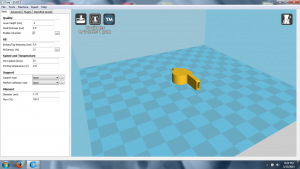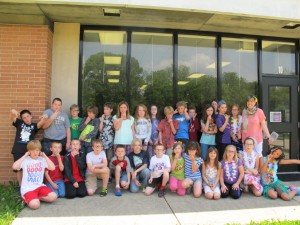
Last Friday I got to talk about how 3D printers work & demonstrate printing to a class at Tzouanakis intermediate school in Greencastle. A lot of the math skills being learned in 4th and 5th grade math, at least in the current common core curriculum, are used when printing on a 3D printer. Obviously simple length and dimensions are needed and almost all 3D printer software controls are entered using metric dimensions. In contrasting a 3D printer with an ink jet printer (which the kids all have seen) we could bring in how coordinates are used with the printer head so the plastic goes on the right place on the printer bed (some of the kids have already been plotting x and y coordinates on charts).

There was lots of other things briefly covered related to math & science, including how the software being used (Cura) estimates how much plastic will be used (both length and weight). By having them measure the diameter of the filament used, we worked through calculating the circle’s area and then volume so they could see how much plastic will be used. Some of the kids have been exposed to unit volumes in the current curriculum, and while it was covered pretty rapidly perhaps the rest will remember it when they get that in more depth next year.
We also talked about the temperature settings and how that melted the plastic, asking if the 206 degree setting was hot enough to melt plastic. Some of the children that have been overseas immediately recognized that this was in centigrade rather than degrees F, so we worked through a conversion equation so everyone could realize these were oven like temperatures.

After printing out a mini-whistle, I then showed them how the scaling function could change the size with a few clicks and re-printed a larger whistle. Most of the kids guessed correctly that the larger whistle would have a lower sound/pitch, but there was a lot of looking around to see who was raising their hand when they were asked to vote.
A special thanks to Mrs. McCoy for allowing me to come into her classroom for the printing demonstration. The class was scheduled at the end of the day & each of them got a 3D printed mini-whistle. Hopefully their parents are still speaking to me! I certainly hadn’t realized how loud 28 small plastic whistles blown at the same time would be!! You can listen to it in a video here…